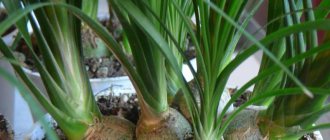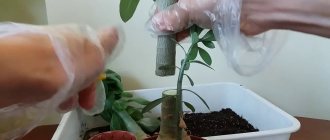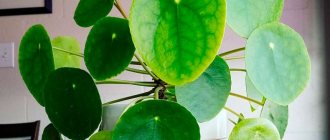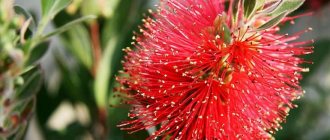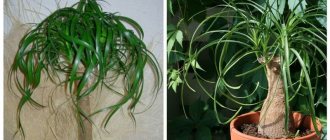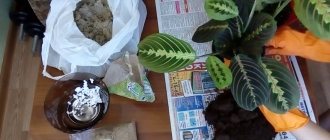- Introduction
- Top dressing from sowing up to 1.5 months
- Feeding from 1.5 to 2.5 months
- Feeding from 2.5 to 5 months
- Feeding after 5 months
- Feeding an adult plant
- Important
- Other fertilizers
Top dressing from sowing up to 1.5 months
In the germination stage
(sowing - 1.5 months) adenium remains from the moment of germination until the end of its maintenance in the greenhouse. At this time, it is not recommended to use any fertilizers in the substrate, because adenium has a natural ability for initial rapid growth. Use liquid fertilizers high in nitrogen (N) to spray the leaves 1-2 times a week. The content of phosphorus (P) and potassium (K) should be 20-30% lower than nitrogen (N). Recommended ratio of elements in fertilizer: 20(N)-15(P)-15(K).
At this stage, liquid fertilizers for cacti and succulents can be used with the appropriate combination of NPK and microelements, as a rule, they contain the optimal concentration of nutrients and the required level of acidity.
Planting in the ground, transplanting
The soil for adenium is selected to be light. For it, loose soil with a high content of nutrients is chosen. It must have high permeability to moisture and oxygen. The soil acidity level is recommended with a pH of 5.5-7.
Flower growers advise using store-bought peat-based mixtures with coconut fibers. These are ideal fertilizers for adenium. For the plant, you can use mixtures for succulents, universal soil with loosening and structuring components.
Making your own mixture for planting is also possible. To do this, take five parts of soil substrate, three parts of leaf soil with humus, two parts of vermiculite, river sand and perlite. Additional feeding for adenium in the form of charcoal will also not hurt.
Feeding from 1.5 to 2.5 months
In the adaptation stage
(1.5 months - 2.5 months) adenium is deprived of its greenhouse contents and gradually adapts to the environment. Spraying the leaves with liquid fertilizer continues 1-2 times a week, but the ratio of elements changes to equal. Recommended ratio of elements in fertilizer: 20(N)-20(P)-20(K).
At this stage, you can use fertilizers for spraying: “Plantafol 20:20:20” - 20(N)-20(P)-20(K), “MASTER 18:18:18+3” - 18(N)-18 (P)-18(K), "FERTICA LUX" - 16(N)-20(P)-27(K), "FERTIKA CRYSTALON UNIVERSAL" - 17(N)-16(P)-21(K).
Kinds
Adenium boehmianum / Adenium boehmianum
The flowers of this species differ in color from the others. The flowers are white-blue or lilac-pink, the corolla tube and throat are purple.
- Nidularium - care, photos, types
Adenium multiflorum / Adenium multiflorum
This species reaches 2.5 m in height. The trunk branches at the top and becomes woody with age. The flowers are the same as those of Adenium obsumum, but there are more of them.
Adenium obesum (obese) / Adenium obesum
Another name is adenium obese. This species grows up to 1.5 m in height. The plant grows slowly. The trunk becomes woody over time, branches in the upper part, and is brown-gray in color. The leathery leaves grow at the ends of the branches, grow up to 10 cm in length, and are gray-green in color. Adenium blooms in summer, flowers are red, white or pink up to 6 cm in diameter; collected in corymbose inflorescences.
Feeding from 2.5 to 5 months
In growth stage
(2.5 months - 5 months) adenium remains from the moment of picking until it is ready to bloom. During this period, the plant is able to grow quickly, which requires more nutrients. Therefore, when transplanting seedlings into separate containers, long-acting fertilizers are added to the soil to nourish the plant throughout the next year. Also, spraying the leaves with liquid fertilizer 1-2 times a week continues. An equal ratio of elements in all types of fertilizers is recommended: 20(N)-20(P)-20(K).
At this stage, you can add long-term fertilizers to the substrate, such as “Orgavit” horse, “Fasco” chicken or organic matter in the form of “Hostes” horse manure in pressed sticks 1-3 cm in size (pellets). Plants grown in substrates containing horse manure differ significantly in better development from their counterparts, BUT!!! It must be remembered that pure organic fertilizers in the form of horse manure, mullein, and bird droppings are dangerous for the root system of the plant due to the high Nitrogen (N) content and the creation of an excessive concentration of salts in the soil. It is also necessary to take into account that when using pure organic matter or other strong fertilizers, plants require stable, long daylight (phytolamps can be used).
To avoid problems with the possible consequences of adding pure organic matter, it is recommended to add long-acting fertilizer “Osmocote Bloom” to the substrate, each granule of which contains all the basic nutrients: nitrogen, phosphorus, potassium and a full set of microelements in a form accessible to plants. The composition pays special attention to elements that contribute to beautiful and abundant flowering.
After an in-depth analysis and analysis of all possible options, this drug turned out to be practically the only one allowed and recommended for application to the soil when growing adeniums in the first year of life. This form of Osmocote manages to complete its long-term effect before the onset of the dormant period, and if used correctly and in combination with other indicated means, it can promote flowering before the onset of stagnation.
For early winter sowing, it is recommended to use Osmocote Exact Standard High K 5-6, subject to the correct recommendations.
Fertilizers used for spraying: “Plantafol 20:20:20” - 20(N)-20(P)-20(K), “MASTER 18:18:18+3” - 18(N)-18(P)- 18(K), "FERTICA LUX" - 16(N)-20(P)-27(K), "FERTIKA CRYSTAL UNIVERSAL" - 17(N)-16(P)-21(K) .
Botanical description
Adenium (lat. Adenium) belongs to the Kutrov family of plants. The genus includes approximately five plant species. This succulent lives in South and Central Africa. Indoor adenium - shrubs or small trees; in indoor conditions it grows up to 35 cm in height. The trunk is thick. The leaves are velvety and shiny. The flowers are quite large, dark crimson and white. Adenium has received many names among the people. The most common is Desert Rose, due to the similarity of the flowers to rose flowers.
Feeding after 5 months
Flowering stage
(from 5 months after sowing) in adenium occurs 5-10 months after sowing, depending on the content. A prerequisite for flowering is prolonged bright lighting during all previous stages, as well as constant maintenance in the temperature range of 22-35°C. Because Since these conditions are rarely met at home, flowering usually occurs only in the second year. In order to help adenium bloom, from this period begins spraying the foliage 1-2 times a week with liquid fertilizers high in phosphorus (P) and potassium (K) and low in nitrogen (N). Recommended ratio of elements in the fertilizer: 8(N)-15(P)-15(K).
Fertilizers used for spraying: “Plantafol (or Plantafid) 10:54:10” - 10(N)-54(P)-10(K), “MASTER 13.40.13” - 13(N)-40(P)- 13(K), "FERTICA LUX" - 16(N)-20(P)-27(K) or "Peters Professional Blossom Booster" (coming soon!) - 10(N)-30(P)-20( K).
Care
Despite the exotic origin of adeniums, they are relatively easy to grow.
One of the most unpretentious species, which takes root even among inexperienced gardeners, is considered obesum (adenium thick). In order for plants to delight with their full development and regular flowering, optimal living conditions should be created for them, close to the natural environment. This involves meeting the following requirements:
- sufficient illumination;
- optimal temperature conditions;
- compliance with the watering and fertilizing regime.
These tropical succulents are very demanding when it comes to light. For normal development, adeniums need daylight, the duration of which is at least 12 hours. The use of special lamps allows you to compensate for the lack of natural light.
To grow healthy and regularly flowering succulents, it is important to ensure a stable indoor temperature. The most comfortable temperature range for them is considered to be within 30–33°
A short drop in temperature within 5° is not dangerous for these plants, however, strong changes should be avoided. It is also not recommended to increase the room temperature above 38°. Such conditions cause adeniums severe discomfort and can cause them to wither.
Feeding an adult plant
Adenium shows the fastest growth at the age of up to 1 year, then slows down slightly at the age of 1-3 years, and noticeably slows down in growth after 3 years. Further application of fertilizers depends on the goals pursued. For example, for frequent and abundant flowering, with appropriate maintenance, plants are fed in the same way as at the flowering stage with a decrease in nitrogen content (N) and an increase in phosphorus (P) and potassium (K): 0-10(N)-15- 30(P)-15-30(K).
After the first real dormant period, adenium is considered an adult plant, for feeding which Osmocote Exact Standard High K 8-9 applied to the soil is used in combination with spraying Plantafol 5:15:45 - 5(N)-15(P)- 45(K).
Bloom
Adenium is a succulent that blooms beautifully. It blooms for the first time in adulthood - over 4 years.
The flowering of adenium is a spectacular sight. Depending on the variety, rose-like flowers may appear on the plant from spring to autumn. The duration of flowering also depends on the variety. Sometimes the process does not stop for six months. Nature did a great job creating large funnel-shaped flowers. In some varieties, their diameter can reach 0.15 m. The “design” of the petals is original: they can be either monochrome or “painted” with strokes, dashes and spots.
The texture of flowers is varied. The petals are simple, velvety and terry. The color is amazing: it varies from milky white to all shades of red and purple. There are specimens painted in black and red tones. Collectors of rare flowers consider cream and yellow species especially valuable.
Temperature
This is a heat-loving plant. For normal growing season, it needs to be in comfortable conditions, so it is important to observe the temperature regime and keep the flower from spring to autumn at a high temperature - up to + 25 - 30 ° C, and during winter, when the dormant period begins, the temperature is reduced to + 15 ° C.
Spraying
Caring for adenium indoors strongly recommends keeping the plant at high air humidity. This is especially important during the active growing season, from March to mid-September. To do this, the bush is often sprayed.
When flowering begins, the plant is sprayed rarely and very carefully, trying not to touch the delicate petals.
They maintain humidity in other ways: place a container with a plant in a tray with wet expanded clay or next to an aquarium, use air humidifiers.
Lighting
For good development of the adenium plant, it is important to choose the right lighting. Experienced flower growers recommend keeping the premises in the southern sector. Here the direct rays of the sun will be directed at it for at least 5.5 hours a day. This time is enough to recharge with energy and not burn the leaves with aggressive rays.
In the spring, after emerging from dormancy, the flower is gradually accustomed to light, without immediately exposing it to direct sunlight. If it receives little light, it will stretch out and grow poorly.
In order for the crown of the tree to develop symmetrically, it is recommended to periodically rotate it on the windowsill, exposing first one side or the other to the light.
Watering
The tree is a succulent plant that independently stores moisture.
Therefore, home adenium is watered only after the substrate has dried. In winter, watering is carried out very rarely, and if kept at a temperature of about + 15 ° C or slightly lower, do not water at all. In spring, irrigation is resumed only when three weeks have passed after the formation of the first buds and the natural growth of the tree begins. Use well-filtered lukewarm water.
Pot
When transplanting, replace the pot. Experienced gardeners advise choosing light-colored plastic containers to protect the plant’s rhizome from overheating. The pot should be wide and deep so that the root system of the bush and a thick layer of drainage fit well there. There should be drainage holes at the bottom.
Priming
For good development, a well-chosen substrate is of great importance. You can buy a soil mixture for succulents in the store and add sand (perlite) to it. If you wish, you can prepare the soil yourself by taking for every two portions of leaf and garden soil three parts of sand, a little bone meal and egg shells.
To make the substrate loose and breathable, brick chips, coconut substrate, vermiculite or foam balls are added to it.
Feeding and fertilizer
Feeding and fertilizer give the plant strength and improve its appearance. Adenium does not need to be fed often. Over the summer, up to three feedings are carried out with a solution for succulents, diluted by half. Overfed plants increase the diameter of the trunk and the number of leaves, but reduce the duration of flowering and deteriorate its quality. Fertilizer is combined with evening watering. After the procedure, the plant is placed in a shaded place for a day. In winter, fertilizing is not carried out.
Adenium transplant
Replanting allows you to renew not only the container, but also the substrate.
Along with this update, the plant receives an incentive for further development. Adenium transplantation at a young age is carried out every spring. A mature bush is replanted when its roots completely engulf the earthen ball and begin to appear on the surface of the soil or look through the drainage holes. This usually happens every two years. Completely mature plants are not replanted, only the top layer of soil is replaced. You should carefully examine the root system. Dried and rotten fragments are removed. The procedure will stimulate the formation and development of new roots. The cut areas are sprinkled with charcoal powder and dried. It is also necessary to remove some of the leaves, leaving only the most beautiful and healthy ones. After transplantation, the adenium is watered 5 days later (during this time the soil has time to dry out).
Trimming
To form a spectacular crown in the spring, after awakening, adenium is pruned. To give the crown a tree-like shape, the side branches are shortened by a third. To form a bush, shoots are cut lower. The desired result cannot be achieved in one go. Pruning is carried out purposefully over several years.
Rest period
In mid-November - early March there is a dormant period for adenium, when slow sap flow is observed, leaf growth stops, and buds do not set. In advance, closer to the beginning of November, the lighting is artificially reduced and the temperature of the plant is reduced to + 15° C.
Fertilizing is stopped, the frequency of watering is reduced, and in severe cold weather they stop watering altogether. Make sure that the roots do not get too cold, otherwise the adenium will die.
Important
It is important to remember that for foliar feeding in the form of spraying, the fertilizer used is diluted two to three times stronger than for watering, unless this is specifically specified by the manufacturer. Spraying is carried out in the morning or evening to avoid leaf burns from direct sunlight. The plant must be watered 1 hour before applying fertilizer. The leaves easily absorb sprayed liquid fertilizers. To preserve greater decorativeness, spraying from the underside of the leaf is recommended. It is allowed to water with diluted fertilizers in small concentrations during watering, but care must be taken that the solution does not get on the above-ground parts of the plant.
Diseases and pests
The most terrible disease is root rot from waterlogged soil. It is easier to prevent the disease by taking a responsible approach to watering. If leaves turn yellow in winter, this is a normal physiological process of leaf dying. This way the plant makes it easier for itself to rest, freeing itself from unnecessary “load”.
leaves turn yellow in summer from exposure to drafts or cold, changes in their usual location, or lack of moisture. To avoid troubles, protect from drafts, move them to a warmer place, and water them.
Sometimes the plant is attacked by pests. The most active among them are scale insects, spider mites and mealybugs. Insecticides are used against insects.
Other fertilizers
Depending on the needs of specific plants, domestic and foreign universal fertilizers and monopreparations can additionally be used: • “Brexil Mix” is one of the best chelate complexes of microelements, with a high content of magnesium and zinc, specially designed to prevent and treat chlorosis; • “Brexil Combi” is one of the best chelate complexes of microelements, with a high iron content, specially designed to prevent and treat chlorosis; • “Siliplant universal” is a source of bioactive silicon, which stimulates the development of the above-ground and root parts of the plant, activates photosynthesis, strengthens the trunk and branches; • “Potassium monophosphate” is a water-soluble fertilizer, compatible with most fertilizers used, does not contain harmful impurities, accelerates and prolongs the flowering of plants. For spraying, a solution with a concentration of 0.1-0.2% is used; • “Calcium nitrate” is the only source of water-soluble calcium, which regulates the flow of nutrients into the plant, improves the development of the root system, forming new root hairs, through which the bulk of nutrients and water enters the plant from the soil. For spraying, a 1 - 2% solution is used; • “Potassium nitrate” is a nitrogen-potassium water-soluble fertilizer for feeding vegetable, fruit, flower and ornamental crops, helping to optimize the suction power of roots, balancing the rate of respiration and photosynthesis, and improving the structure of plant tissues. For spraying, a 1.5 - 2% solution is used; • “Magnesium sulfate” - eliminates magnesium chlorosis, expressed in yellowing of leaves due to the disappearance of green pigment from them. For spraying, a 1.5 - 2% solution is used; • “Boron” - eliminates unhealthy light coloring and curling of foliage, deformation of seed pods; • “Copper” - eliminates the appearance of small foliage, underdeveloped flowers, twisted seed pods; • “Iron” - eliminates yellowing of leaves with green veins, slower growth and stunting of young shoots; • “Gumate+7” and “Orton-humate” are organo-mineral preparations based on microelements, humic acids and their salts, containing minerals in a form accessible to plants.
This article discusses basic and easily accessible drugs. Preference is given to domestic producers, but a solution to the issue of fertilizing can be the use of imported fertilizers from the world's leading manufacturers, who have been conducting research to improve the quality of products for decades and provide entire lines for all stages of plant growth. It is worth highlighting the following brands: Advanced Hydroponics (Holland), Advanced Nutrients (Canada), BAC (Holland), BioBizz (Holland), Etisso (Germany), GHE (France), Hesi (Holland), Plagron (Holland).
All fertilizers, protective and preventative means for the rapid and healthy growth of adeniums are collected here.
© Adenium at home. Author's article! Copying materials is possible only with reference to the source.
Popular varieties of adenium
Adenium variety 'Aden. Best of Siam variegata'
A tree with pale green, almost white, leaves and double pearl-pink flowers.
Adenium variety 'Bright Gems'
A well-branched plant with lanceolate leaves and white-pink flowers (the lower part of the petals is dark scarlet).
Adenium variety 'Chalkng Pink'
A tree with velvety emerald leaves and large pink flowers.
Adenium variety 'Double Color'
Originally colored flowers stand out against the background of emerald leaves: when they appear they are black, but after a few days they turn red.
You can endlessly admire a tree with an original trunk and spectacular flowers and see it in a new way every time. By experimenting with pruning the crown, you can “design” an unusual plant. From a small seed or a short cutting, a gardener can grow a unique beauty.
Features of growing seeds
It is not difficult to purchase planting material. It can be found in stores or purchased online
It is worth paying attention that the seeds should be in the form of light brown tubes
The highest percentage of their germination remains in the first six months after collection. Then the probability of successful seedlings decreases significantly.
When breeding adeniums by seed, plants may lose their varietal characteristics. As a result, flowers of completely different shades may grow.
When growing, some features should be taken into account:
- Sow seeds from April to June;
- Before planting, soak the seeds for a while in warm water;
- Prepare the mixture for sowing according to the recipe described above;
- The container for seedlings can be of any kind, but drainage holes must be made at the bottom;
- When planting, the seeds are not buried in the soil, but are laid out on the surface of the soil and slightly pressed;
- Afterwards, spray the soil with water from a spray bottle and cover with film;
- Ventilate daily;
- During planting and growing, the temperature should be maintained at 30-35°C. At lower temperatures, the likelihood of seed germination is significantly reduced;
- When the seedlings already have 2 leaves, they can be planted in separate pots;
- Flowering of adeniums grown from seeds begins after 2 years.
Thanks to this method, you can grow many adeniums at once. It will be much cheaper than buying a flower in a store.
How to form a caudex
Caudex is a very interesting “detail” of adenium, giving the plant an unusual appearance. It forms with age on its own in the form of a bottle, but if desired, you can get other forms. To work you will need:
- grown seedling with 3-4 leaves;
- container for planting;
- small plastic circle;
- garden var;
- sharp knife.
The adenium trunk can be formed.
The caudex is formed as follows:
- The seedling is carefully removed from the soil.
- Using a disinfected knife, trim the tap root and crown of the plant, followed by treating them with garden varnish.
- The plant is placed on a plastic circle. The roots are spread over it in the desired direction.
- Sprinkle with a small layer of earth and lightly tamp.
- Water the plant only a day after the procedure.
The formation process is quite long. It can last for several months, or even years. But the result is worth it. Specialists are able to create real masterpieces in the form of figures of animals, birds, etc.
Adenium is no longer uncommon. It can be purchased in a store or ordered online. However, for real lovers, growing a miracle tree from seeds on their own is a matter of principle. And it’s quite simple to do this, if only you would like to.
Table: manifestation of care errors and how to correct them
| External signs | Probable Cause | How to fix the situation |
| Leaf blades turn yellow and fall off. | A natural reaction of the plant, adenium is preparing for a period of dormancy. | Provide the flower with suitable conditions, move it to a cooler place. |
| The caudex became soft and spots appeared covered with yellowish fluff. | The caudex is rotting. | Reduce watering and provide the plant with bottom heating, for example, place the adenium on a radiator. |
| Leaf blades become deformed, curl, and spots appear on them. | The concentration of fertilizers has been exceeded. | Stop feeding completely or replant the adenium into a fresh substrate. |
| The tips of the leaves dry out. | Potassium deficiency. | Feed the plant with potassium fertilizer. |
Reproduction methods
Growing adenium from seeds
When stored for a long time, adenium seed loses its germination capacity; therefore, only fresh seeds should be used for sowing. Their sowing is carried out in the last winter or first spring weeks.
The container is filled with a substrate consisting of charcoal, sand and vermiculite. The seeds need pre-sowing preparation; for this they are placed in a solution of potassium manganese for 30 minutes, and then they are kept for several hours in a lukewarm Zircon solution. The seeds must be distributed over the surface of the substrate, and then they are covered with a thin layer of soil mixture. The crops are placed in a warm place (from 33 to 35 degrees), after a week seedlings will appear. If the crops are located in a cooler place, the seedlings may appear later or this may not happen at all. When the plants appear, they will need to be illuminated with fluorescent lamps, they will also need to be provided with regular ventilation, and the air temperature in the room should be at least 18 degrees.
After the first two true leaf plates have formed on the flower, they begin to gradually care for it like an adult specimen. And when 2 more leaf plates are formed, the seedlings should be picked into individual containers.
Cuttings
Propagation by apical cuttings is a rather complicated process, as they can easily rot. Cuttings are carried out in summer or spring. The cuttings need to be divided into parts, the length of which should be about 12–15 centimeters, then they need to be dried by treating the sections with charcoal. In order for the cuttings to take root, you need to use perlite, a mixture of sand and charcoal or small expanded clay. It is necessary to pour sand or small charcoal around the root collar, thanks to this the base of the stem will not rot. Cuttings need bright sunlight, and the air temperature should never be below 25 degrees. The soil should not be over-moistened. If everything is done correctly, the cuttings will take root after 4 or 5 weeks.
How to propagate by layering
In May and June, such a succulent can be propagated by air layering. Take a very sharp knife and use it to make a circular cut on the shoot (the stem should be 20 mm in diameter). After the incision site has dried, it should be treated with a solution of a product that stimulates root growth. Wrap this place with sphagnum moss, which should be wrapped on top with opaque cellophane. Don't forget to regularly wet the moss. After about 4 weeks, roots should appear, then the cuttings are separated from the mother plant and planted in a container filled with substrate intended for an adult bush.
Reproduction by grafting
To graft such a crop, you can use another adenium or Oleander. Make cuts on the scion and rootstock using a very sharp knife, then they are combined with each other, and then the plants are firmly held together (you can use a special spray). Make sure that the air temperature in the room is not less than 30 degrees, the air humidity should be high, and you will also need bright lighting. The new bush must be protected from direct rays of the sun, and the sprouts that appear on the rootstock must be cut off immediately.

